Abstract
In discussions on urban food security and healthy aging, urban agriculture is described in the context of changing approaches to sustainable urban development under crises. Space planning-related urban agriculture practices, such as edible landscaping combing design and small-scale crop production, are the primary active strategies and environmental policy tools. This paper addresses urban food security and health aging by practicing campus agriculture and community gardens around National Taiwan University. In particular, this study adopts participatory action research, participatory observation, and semi-structured, in-depth interviews as the research method. We examined the challenges and benefits of implementing urban agriculture in Taipei. Further, we proposed that urban agricultural space building and planning based on a social support network of urban agriculture can effectively address food supply and healthy aging for an aging urban society to some extent.
1. Introduction
In “Jamie Oliver’s Food Revolution”, as the famous English chef Jamie Oliver said, “This is a lost new generation: our children don’t know how to cook, how to get food, let alone how to eat healthy”, (Neil Lovell, CEO of The Good Foundation of Jamie Oliver Group, 24 September 2014, Taipei).
With the rapid development of urbanization, humans face two challenges: health aging and food security. Firstly, urban food supply should be moving to a circular system. In meeting the needs of the urban population, the industrial food system “growing-harvesting-transporting-processing-packaging-wholesaling-retailing-eating-disposing,” is becoming increasingly unsustainable [1,2]. Although the global proportion of undernourished people has decreased from 18.7% (1990) to 11.3% (2014) globally between 1990 and 2014, the United Nations failed to achieve the millennium development goal of halving the proportion of undernourished people [3]. The FAO report, The State of Food Security and Nutrition in the World 2021, estimates that between 720 million and 811 million people worldwide will be hungry, which is more than half of Asians (418 million) and one-third of all Africans (282 million) [4]. In this context, urban agriculture (e.g., rooftop farms, indoor farms, vertical farming), as edible landscaping becomes a possible way to cope with food supply under food crises. Meanwhile, it brings agricultural-food back to cities in various countries and cities worldwide and reconstructs the linkage between people and their local food system [5,6,7]. Urban agriculture is still an emerging planning and architectural design theory. There are still many challenges to implementation that must be addressed. Would urban agriculture be positioned to provide agricultural products for urban residents or to increase social welfare through food and agriculture education and enhance community vitality [8,9]?
The second challenge is the aging trend of the global population, especially regarding post-war baby boomers [10]. According to the “World Population Prospect of 2019 Revision”, by 2050, one in six people worldwide will be 65 years of age or older (16%), compared to 11 (9%) in 2019 [11]. The aging of society brought about by urbanization and the challenges of urban food supply are becoming complicated in many respects. Healthy aging has gradually received the attention of social workers, and the problems of the elderly have been redefined because its meaning has extended to social and work values [12].
Along with diversifying healthy aging and the rise of urban agriculture, space planning–related urban agriculture practices—described in the context of changing approaches to sustainable urban development, such as edible landscaping, combing landscape design, and small-scale crop production—are the primary active strategy to meet social and ecological needs [13,14]. However, urban planning and spatial design often focus on spatial planning while ignoring the connection between food and planning, emphasizing instrumental rationality and neglecting citizen participation. It is a necessity to establish shorter, more sustainable agricultural practices and local food supply chains [15]. How can we enhance urban food security with limited agricultural land and resources and feed a growing number of people and seniors? How do we best utilize spaces to produce quality agricultural products and create a network of community relationships and actors in an increasingly urbanized population? How do we determine effective models for sustainable farming? This study addresses this problem through the practice of vertical agriculture and community gardens around National Taiwan University. This paper is organized as follows. The first section presents the introduction. The second section sets forth the literature review, focusing on urban agriculture in practice from global, Asian, and Taiwanese contexts. The third section explains the research design, including why and how this paper adopts the research methods (i.e., participatory action research, participatory observation, and semi-structured, in-depth interviews). The fourth section discusses the first case study, a campus farm practice by participatory planning and action research. On the other hand, the fifth section discusses the second case study, a community farm practice by participatory planning and observation. Finally, the last section presents the discussion and conclusion. Moreover, we examined the challenges and benefits of implementing urban agriculture in Taipei and proposed that urban agricultural space building and planning based on a social network can effectively address food security for an aging urban population.
2. Literature Review
Farming has been carried out in different ways throughout the evolution of global agriculture, from riversides to forested areas to all arable regions, especially after the Second World War. Agricultural mechanization, new seeds, pesticides, and fertilizers have significantly increased crop yields, leading to a dramatic increase in the world’s population and urbanization [16]. However, rapid global urbanization, coupled with climate change and natural resource pressures, has forced the industry and academia to think about food supply and improving the sustainability of agriculture, predominantly urban and peri-urban agriculture [17]. This includes not only the analysis of agricultural practices in and around cities but also food cultivation, processing, and distribution through intensive plant cultivation and animal husbandry. As such, this review comprises three parts: urban agriculture in concept and development, urban agriculture practices in the context of health-aging urban agriculture in Taiwan.
2.1. Urban Agriculture and Its Practices
2.1.1. Development and Types of Urban Agriculture
Urban agriculture is as old as cities [18]. It is a challenge to conceptualize what urban agriculture means; the definition and form of urban agriculture are varied. It has been constantly reinterpreted over time, such as urban agriculture, garden city, urban farms, citizen farms, edible gardens, urban farms, community gardens, collective gardens, and therapeutic gardens [19].
The authors believe that there are two main contexts of urban agriculture: garden city and urban farm. (1) In terms of a garden city, a concept proposed by Ebenezer Howard in 1898 in the book Garden Cities of To-morrow, the concept of enclosing human communities in areas of fields or gardens is a way to balance the ratio of residential, industrial, and agricultural area [20]. In 1903 and 1920, two experimental garden cities, Letchworth and Welwyn, were established, both of which remain healthy and sustainable communities today [21]. We found that revisiting Welwyn town after one hundred years, Howard proposed a very detailed localized food system that connected the garden city and its green spaces in a productive symbiotic relationship in Welwyn. We recognized the forward-thinking of the Howardian garden city on food supply. This design initiative provides ideas for seeking food systems and planning, design, architecture, governance, and place management to create healthy and resilient cities. Parham argues that it is better to return to the Howardian garden city, a highly functional and resilient town with food-centered urbanism, rather than looking for guidance from Edible Garden Cities [22]. Meanwhile, urban farms are widely recognized as an important model and inspiration for food supply, education, leisure, and entertainment. Parsons Farm (Children’s School Farm), located in De Witt Clinton Park of New York City, was an urban farm with over 458 individual plots covering 1100 farmers. It was established in 1902 to educate young people through farming activities, open their eyes to the world beyond the slums, and engage them in healthy activities that would benefit their well-being and development, as well as promote neighborliness [23]. However, when food production was no longer the most pressing need of the citizens after 2000, the kind of school farms of the past that revisited the relationship between children, nature, and education, developed nature studies, and created school gardens to provide growing experiences, took on a new meaning. In addition, Seattle’s Picardo Farm is particularly representative. It is the oldest community garden in Seattle, created by a civic movement of students and residents, and is unique in that the land was purchased by the Seattle government and made available to the community residents for cultivation. This model of land use is not common in Western countries but is relatively common in Taiwan.
The development of urban agriculture in the United States has transitioned from food production and children’s education to food production and recreation. The situation in Europe and Japan started mainly with food production, and most of the development was caused by food crises at the beginning, especially during World War II and the oil crisis. In 1919, the German government enacted the “Citizens’ Farming Act” and its development model, which is the earliest prototype of urban agriculture. Urban agriculture first appeared in a book titled Agricultural Economic Geography by a Japanese scholar Shiro Aoshika in 1935. The agricultural economist Thompson formally put forward the concept of urban agriculture in a paper, “Urban Agriculture in Southern Japan”, in 1957 [24].In 1996, the United Nations Development Programme promoted urban agriculture, defining it as “the agricultural activity of producing, processing, and marketing food or related agricultural products in urban or peri-urban areas using local resources and intensive production methods.” In the 1990s, Smit et al. (1996) [25] defined urban agriculture predominantly as an industry that produces, processes, and markets food products primarily to meet the daily needs of the town, city, or metropolitan consumers for land and water scattered in urban and peri-urban areas adopted by the United Nations Development Programme [26]. Nugent (2000) submitted a revised definition, where urban agriculture is defined as an industry located within (intraurban) or on the periphery (peri-urban) of a town, city, or metropolis [27]. It grows or raises, processes, and distributes various food and non-food products in and around an urban area, providing human and material resources, products, and services to the metropolitan area. In addition, existing definitions of urban agriculture refer to that in and on buildings, such as rooftop gardens, rooftop greenhouses, and vertical farming. The concept of vertical agriculture is growing plants or animals inside skyscrapers or on vertically inclined surfaces [27]. Building integrated agriculture places high-performance hydroponic greenhouse systems above and within mixed-use buildings to exploit synergies between the built environment and agriculture-like energy and nutrient flows [28]. The scholars also referred to it as “Zero-Acreage Farming (Z-Farming)” to describe all types of urban agriculture characterized by the non-use of farmland or open space, thus distinguishing building-related forms of urban agriculture from those found in parks, gardens, and urban wastelands [29].
2.1.2. Productions and Reproductions of Urban Agriculture in the Asian Region
The further development of urban agriculture began in the 1990s with the United Nations Development Programme’s Urban Agriculture Initiative. Since then, urban agriculture has expanded globally [30]. This program has contributed to the rapid growth of urban agriculture in areas such as Brazil, Africa, and Asia. Specifically, the development of urban agriculture in Asian, African, and Latin American countries has taken on a more diverse appearance, with studies focusing on the applicable functions, development policies, community governance, and economic and cultural effects of urban agriculture. Existing research points to the development of urban agriculture under the themes of community awareness, placemaking, food, health, place attachment, nature, and education. Urban agriculture needs to be placed in urban areas suitable for agricultural use, and the sustainability of community farms needs to be in cohesive communities with public institutions [31].
Urban agriculture has gradually become a feasible way to address food supply, food security, and the sustainable urban development of cities. Urban agriculture in Japan is mainly concentrated in three metropolitan areas: Tokyo metropolitan area, Osaka metropolitan area, and Nagoya metropolitan area [32]. They are (1) guided by reasonable government policy, (2) co-operated by strong local agricultural cartels, and (3) farmed by influential urban farmers. The concrete manifestations of urban agriculture include two aspects: Firstly, the government implements urban planning and a land tax system and guides the regional macro layout and planting differentiation. Secondly, efficient local cooperatives organize activities to popularize horticultural production facilities, agricultural technology skills training, and the logistics pipeline “farmers & company” model. The purpose is to achieve two goals. One is to protect the interests of farmers and the prices of agricultural products, and the other is to achieve a high-value rate of agricultural commodities. Implementing organic green agriculture is not only the fundamental guarantee of Japanese agricultural products but also the critical core of competitiveness [33].
Singapore is now a “garden city” but lacks natural and water resources. After Lee Kuan Yew became the leader of Singapore, he pushed urban agriculture with high-technology skills to change agricultural products that mainly relied on imports in the past. One of his strategies was implementing intensive and efficient methods (desalinated, recycled, and imported water) to address water shortages and realize ecological diversification and sustainable economic development [34]. As a result, modern intensive agricultural science and technology and agricultural biotechnology parks focus on new agricultural technology research and often operate as ecological aquatic farms.
Regarding urban agriculture in Japan and Singapore, many urban farmers have emerged. Urban farmers typically choose their role (as opposed to traditional farming, which is not always desired), and most have combined traditional work and leisure with urban agricultural life. Agriculture has been a means of survival and has recently become a form of leisure tourism. However, urban agriculture presents a way and choice of life and living. Furthermore, the scholar LaCroix presents the development of urban agriculture in declining cities and how urban agriculture can contribute to urban redevelopment, growth, and development [35]. Cleveland is in a post-industrial era and is utilizing unused or underutilized land to re-plan, design, and imagine more sustainable community resources to nurture local engines of economic growth and new development. It embarks on the development of green infrastructure (e.g., ecosystem restoration, rehabilitation, and green space) and productive landscapes (agriculture and alternative energy sources such as urban agriculture/commodity agriculture as beneficial land uses). These initiatives create a new way forward and leverage opportunities for innovation.
Urban agriculture is practiced worldwide, but mainly in high-income countries, especially in the United States, Canada, and Europe, where there is a focus on sociocultural benefits. Although urban agriculture is also present in low-income countries, it is mainly oriented toward market-oriented food production [36]. Specifically, Krikser et al. (2016) classified urban agriculture as belonging to three distinct, overlapping categories: self-supply, sociocultural, and commercial [37]. Self-supply mainly refers to growing vegetables and fruits on private balconies or in private gardens. Sociocultural urban farming activities are primarily for community or school campuses and community college gardens. Commercial mainly represents market profit, in which the operators are mostly adaptation companies producing agricultural products. Based on the above studies, urban agriculture can be divided into the following elements: food security and social inclusion, economic development, education, and cultural health. As Figure 1 shows, there are eight goals in urban agriculture, and many existing cases happen.
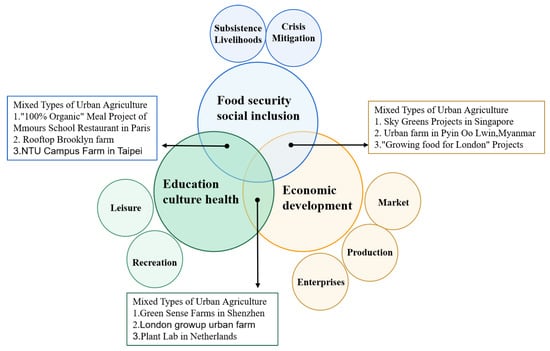
Figure 1.
Typology of urban agriculture practices. Resource: according to the concept of References [32,33,34] the authors drew and arranged the above figure.
In addition to food security, urban agriculture research focuses on food production and its social and cultural impacts. There are many terminologies, such as good social relations, security, access to adequate income, family assets, and healthy food. Urban agricultural spaces and practices can bring enormous sociocultural benefits. Ilieva et al. found that, contrary to the traditional notion that “urban agriculture is insignificant and inefficient compared to traditional agriculture”. It is evident that urban agriculture has many benefits [38]. Ilieva et al. analyzed 272 urban agriculture-related journal papers and systematically reviewed and summarized the analyses [38]. They found that the research involved four main thematic areas, as Table 1 shows: (1) Participation and cohesive communities: Social cohesion is a sociocultural benefit of urban agriculture. Urban agricultural spaces support these communities’ connection and cultural identity. (2) Health and wellbeing: Urban agriculture has a positive impact on participants’ emotional and psychological wellbeing. Urban agriculture also enhances food security and, with appropriate farming activities, can bring participants a sense of happiness and personal fulfillment. (3) Economic opportunity and workforce development: these are essential; however, they underestimate the sociocultural benefits of urban food production spaces and the social practices of enterprises. (4) Education: The practices and education associated with urban agriculture are not limited to horticultural and agricultural knowledge. Still, they encompass “food citizenship” skills, management skills, professional skills, knowledge of health and nutrition, culinary skills, and an understanding of food systems. Since urban gardens, community gardens, and farms often host students or provide educational activities, participants benefit from educational activities related to developing gardening skills and food-growing knowledge, increased health and nutritional learning, personal growth, and self-confidence.

Table 1.
A study of four themes in urban agriculture.
2.2. Urban Farm Spatial Practices in the Context of Health Aging
According to the “World Population Prospect of 2019 Revision”, there will be 16% 65 years of age elderly people by 2050. The aging of society brought about challenges to urban food supply and the problems of the elderly (social values, work values, well-being values). As discussed above, urban agriculture could be an active strategy that social workers, policymakers, and community and urban managers can use to meet the elderly’s social and physical needs.
For a healthier aging society, the authors purposed that some strategies must be considered.
The first strategy involves changing the border between cities and agriculture pushing the “city in the agricultural production into agriculture in the city”. Lefebvre (2009) indicates in “Space: social product and use value”: “This passage from production in space to production of space occurred because of the growth of the productive forces themselves and because of the direct intervention of knowledge in material production. This knowledge eventually becomes knowledge about space, information on the totality of space. Production in space is not disappearing, but it is oriented differently. One can speak of an economy of flow: the flow of energy, the flow of raw material, the flow of manpower.” [39] (p. 186). Based on the evolution of human society, it is evident that human civilization is built upon agricultural production. Agriculture was a means of production, emphasizing agricultural production itself in the city. However, the role of agricultural output gradually changed after the Industrial Revolution. In modern society, the production of space was completely developed, and agriculture is no longer merely a means of production; it can also be a style of tourism or otherwise.
The second involves health aging in an aged society. The notion of “the elderly” has been redefined for baby boomers born post-war. They are more willing to choose the vocabulary—vitality, feeling adventurous, or feeling a little younger—to describe themselves. Being elderly does not mean that the function of your body is lost, but it is a life stage in the aging process [40,41]. Considering the environmental conditions (whether a space is pedestrian-friendly, relaxed, a green space environment, and wheelchair-accessible), they cannot always match the physical condition of the elderly. How can we support them to have healthy lives? We must allow older people to experience physical, psychological, and social comprehensive comfortability, and let them continue with positive interactions, such as the opportunity to grow, be independent, and pursue creative requirements to achieve productive aging [42]. In addition, regarding work value, older people have increasingly wished to acquire understanding and support from their communities through work-related activities. Through labor, they can realize their social value, which can help them to ensure their vitality and passion for life. It can also bring them a greater sense of accomplishment. Thus, we need to consider the activities they engage in that may or may not affect their lives and wellbeing; for example, balancing concerns and cost-effective problems when elderly people need medical treatment and care [43].
Thirdly, “City + Agriculture + Nature + People” and ”Social Network”. Heidegger (1951, pp. 4–5) said, “Building is really dwelling, the bridge swings over the stream’ with ease and power’. It does not just connect banks that are already there. With the banks, the bridge brings to the stream the one and the other expanse of the landscape lying behind them. The bridge gathers itself in its own way earth and sky.” From Heidegger’s observation, the construction of things generated the river, bank, land, and bridge, to be a quaternity. The bridge gathered one of four, allowing one to have a site, but only those who keep themselves are at a place (location) [44,45]. The role of the food supply chain is similar to the bridge in Heidegger’s theory, and the social network did not exist in urban agriculture.
Thus, the authors attempted to build the bridge to push social networks, the people, agriculture, and the communities into a single entirety (Figure 2). In the beginning, farming was merely a way of production in space. Still, in the evolution of production, the aim of social networks in urban agriculture gradually began to serve the elderly and promote healthy aging. At this time, urban agriculture is four in one: city (also space, site), agriculture, nature, and people, building social networks is considered as an overall dream fostered by growing.
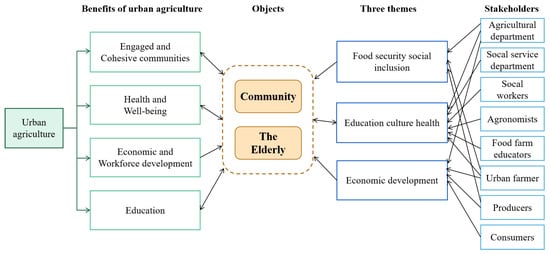
Figure 2.
Social network framework of Urban Agriculture. Resource: drawn by the authors.
2.3. Urban Agriculture in Taiwan
2.3.1. Urban Agriculture Development in Taiwan
Taiwan belonged to an agricultural economy before 1960. Until the modernization of agriculture, it was always a way of life. Between 1960 and 1980, with the rise of industrial and commercial economies, agricultural capital was changed into commercial capital, in which agricultural production output decreased yearly. Even if residents lived in rural areas, they were no longer rooted in agricultural production but tended to be more profitable in modern fields. At this time, agriculture gradually became a way of life. In the last 20 years, urban congestion and environmental and food issues have received attention from the global community [46,47]. Agriculture production functions of leisure, tourism, and education are gradually becoming important. Urban agriculture space is no longer highlighted in the production of agriculture itself but on the emphasis on space (absolute space and the space of social relations network) production. Urban agriculture in Taiwan has developed primarily to curb excessive industrialization, thereby creating a beautiful environment. There are several types of urban agriculture in Taiwan: (1) tourist farms, including open and mature orchards, vegetable gardens, and flower gardens; (2) citizen farms, where farmers provide farmland for citizens to participate in farming; (3) leisure farms are vast leisurely agricultural areas where visitors can not only sightsee, pick fruits, experience farming operations, learn about farmers’ lives, and enjoy the local interest, but also stay for vacations and use as their playground areas [48,49].
In general, urban agriculture in Taiwan has taken different forms according to the autonomy of local governments in each county and city (Table 2). Except for Taipei City, which has a relatively large development, other counties and towns are still in the initial stage of urban agricultural development. As shown in Figure 3, the old-age population in Taipei is increasing, which is both an opportunity and a challenge.

Table 2.
Overview of urban agriculture promotion in key cities in Taiwan.
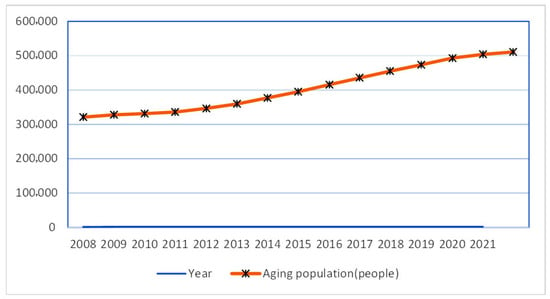
Figure 3.
Aging population in Taipei. Resource: Department of Civil Affairs, Taipei City Government.
2.3.2. Urban Agriculture Development in Taipei
There are three paths to the development of urban agriculture in Taipei. The first is informal operation, which originates from the frugal culture of Chinese society. Food production has been a long-standing but often neglected activity in the city. People tend to plant in nearby public spaces, such as riverbanks, vacant lots, apartment balconies and rooftops. This informal planting is usually only visible to those who live or work nearby. In addition, the government’s water department and parks department prohibit unauthorized planting on public land along rivers and civic parks and will remove it immediately upon investigation. Further, municipal departments (such as hydraulic engineering and parks) prohibit unauthorized planting in civic parks and communal land along the riverside. Once verified, the plant will be removed immediately. This informal planting repeats often. An interesting case (Figure 4) involved a citizen who secretly planted vegetables on the campus of the National Taiwan University without permission. “This is the campus of National Taiwan University. Please don’t use it to grow vegetables. Otherwise, you will call the police and ban it.” (General Affairs Section of National Taiwan University, Taipei, January 2021). “Sorry, after we harvest these vegetables, We will retreat immediately.“(The citizen who stole vegetables, Taipei, 29 January 2021).
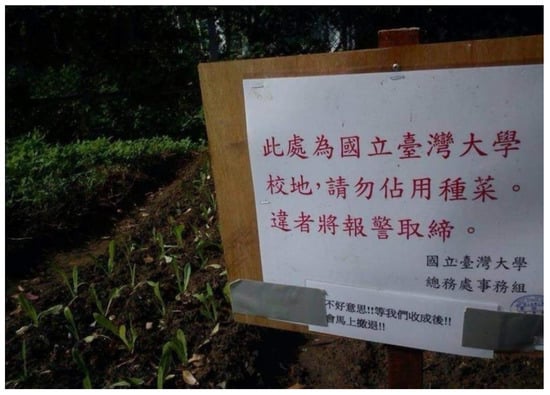
Figure 4.
Informal urban farm at the National Taiwan University. Resource: photo by Facebook group “Road observation college” (Lushang guancha xueyuan).
The second path is the spatial initiative of urban agriculture promoted by the government. Taiwan’s first tourist farm, a tea garden, was established in Taipei in 1980. The Taipei municipal government set up various tourist farms, including tourist vegetable gardens, flower gardens, tangerine gardens, lotus flower gardens, mushroom gardens, strawberry gardens, grapefruit gardens, passion fruit gardens, peach gardens, and dragon fruit gardens. Since 1989, under the promotion of the Taipei Agricultural Association, 17 citizen farms have been set up in Taipei City. The citizen farms combine the functions of agriculture, leisure, and education, with farmers providing farmland for citizens to cultivate themselves. Currently, almost all of the 17 civic farms are full, and the people who participate in the civic farms have developed a close social connection with the land, the crops, and the urban farmer through farming [50].
The third path is the flexible use of public space. Following the “Guidelines for the Management of the Taipei City Government’s Field Base Adoption” and the “Taipei City Park Management Ordinance,” no crops can be grown or harvested on parkland (except for a few parks named edible landscapes, e.g., Jingqin No. 1 Park in Xinyi District). At the time, in Treasure Hill, the residents could grow vegetables for the sake of community activism, so the garden was beautifully named an art landscape instead of a vegetable garden (P1). In the early 2000s, the Treasure Hill artist village (Figure 5), located near Gongguan commercial district, was once a home to retired veterans and was in danger of demolition. Still, thanks to local efforts, the village was preserved and kept with a vibrant life for the indigenous people (the elderly).
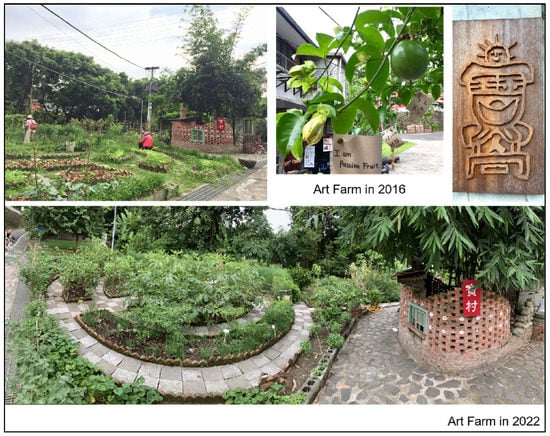
Figure 5.
Art urban farm in Taipei’s Treasure Hill artist village. Resource: photo by the authors.
Taipei’s urban agriculture coexists and can be developed in the above three models. The change occurred in 2014 with the establishment of the Farming Urbanism Network (FUN). At that time, with the high level of public concern about food safety in Taiwan and the political opportunity brought by the Taipei mayoral election, the garden city program, as a progressive social initiative, eventually became the campaign platform of the Taipei mayoral candidate, thanks to active lobbying by FUN. In 2014, after Wen-Je Ko became the mayor of Taipei City, the garden city program became an official urban policy, and Taipei became the first city in Taiwan to include “urban farming in urban living spaces” in its approach to promoting urban agriculture.
On 26 November 2014, Ko Wen-Je became the mayor of Taipei City. Taipei’s garden city policy was drafted for half a year, mainly including (1) integrating the garden base space and establishing a garden bank; (2) establishing an agricultural technology guidance mechanism; and (3) elite management of the garden base [51]. In 2015, he launched the “Garden City Promotion Project” to build “Taipei City as a green, healthy, educational, and living garden city,” which combines the concept of a sustainable ecological city and the development of a food supply chain. Integrating urban agriculture into the living environment can make the city green through edible landscaping, deepening agricultural education and promoting community exchange. Thus, people can plant, grow vegetables, harvest crops, and experience the joy of being an urban farmer, turning Taipei into an idyllic city of green health, education, and life.
Since the promotion of the “Garden City” policy in 2015, there have been more than 600 gardens with a total area of more than 100,000 square meters in 2018 and more than 213,000 square meters and 740 vegetable gardens in 2020. The number of people participating in farming has risen to about 520,000. According to the data from the Taipei City Agricultural Association, almost all of its 17 citizen farms are at total capacity and have low mobility, indicating that the lessees have developed strong feelings about the land [52,53].
3. Research Design
3.1. Research Site
There are two cases in this study (Figure 6). In Case no. 1, the urban farm experiment and farm construction on the campus of National Taiwan University, located at Daxue village in Da’an District of Taipei City, was led by an author-led rooftop vegetable garden’s construction, with a year of action research as the data source. In case no. 2, the community farm was nearby the NTU, located at Xuefu village in the Da’an District of Taipei City. This urban farm was co-constructed by NGOs, the village department, and the students from NTU and National Taiwan Technological University.
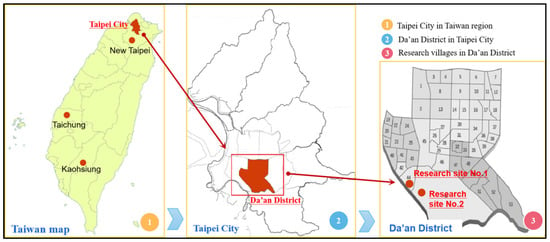
Figure 6.
Research sites.
3.2. Research Methods
This study uses various research methods such as participatory observation, in-depth interviews, semi-structured interviews, participatory design, and participatory action to design and discuss urban agriculture.
3.2.1. Participatory Observation
Some aspects of human life cannot be quantified, but participatory observation can provide insight into their social and cultural contexts [54]. In participatory observation, the researcher adopts the role of a peer bystander as different actors pursued daily activities related to the urban agriculture farms (citizen farms, happy farms, green roofs, small pastoral gardens) from 2014 to 2016 and 2021 to 2022. The researcher took contemporaneous field notes, later augmented by recordings or memory in compiling of a written record.
Specifically, the main considerations for participatory observation of urban farms are as follows:
- The scale of the farm, other facilities of the farm (pipelines, water towers)
- The types of crops grown (vegetables such as cabbage, coriander, radish, water spinach, and green peppers; fruits such as strawberries, peanuts, grapes; and passion fruit; chickens, and honey, etc.)
- Farm cultivation methods (with or without vegetable pots or other modular equipment)
- Soil type (cultivated soil, ordinary soil, mesocosm soil)
- Irrigation method (manual watering, drip irrigation)
- Frequency of watering, weeding, pest control, and fertilization
- Mode of operation of the farm (whether only community members or those interested in opening the garden to the public)
- Motivation: interest, food safety, community activities, environmental awareness, socialization.
3.2.2. Interviewees
This study explores the key persons related to “garden base, find compost, find materials, grow, collect fruits and vegetables, exchange ideas, share agricultural food” by intentional sampling. This study emphasizes the construction and government of urban farms and the social and cultural benefits of urban agriculture from growing to gaining of the research objects. The study uses intentional and snowball sampling to find respondents. From 2014 to 2015 and from 2021 to 2022, the researchers conducted fieldwork in Taipei City, New Taipei City, and Taoyuan City using snowball sampling to identify potential interviewees. As interviewees were found through recommendations from friends or students who shared their experiences of urban agriculture, the researchers found a high degree of participation from respondents, which was conducive to the smooth development of the research and the implementation of in-depth interviews. A total of 17 individuals were interviewed at least once (a total of 26 times), with follow-up interviews with 8 individuals. Each interview session lasted between 30 min and 1 h (Table 3).

Table 3.
Interviewee data.
Internationally, people over 65 years old account for 7%, 14%, and 20% of the total population, which are called aging society, senior society, and super-senior society, respectively. Taiwan Province became an aging society in 1993 and an senior society in 2018. There are 3,802,000 people aged 65, accounting for 16.2% of the total population, and it is already a high-ranking society. More than 80% of Taiwan’s population lives in urban areas with dense food demand. Is there urban farming in the idle space of the city? For example, are urban farms in the corners of urban buildings, on balconies, rooftops, parks, and on the roofs of buildings? How large are they? How many people are involved? Is there a management unit? Do the people in charge of planting have farming experience? Is there a government subsidy program for the urban farms observed? What are the operational issues of the urban farms, including management, human resources, time, funding, and maintenance of operation and vitality? Is there a professional farmer to help?
3.2.3. Participatory Action Research and Participatory Planning
Social psychologist Kurt Lewin was one of the first scholars to promote action research in the 1930s. He combined the implementation of social practice with theoretical research and developed the four cycles of “analyzing and identifying problems, developing solutions to problems, implementing programs, and observing and evaluating implementation results,” which became the actual implementation basis of action research [55]. Action research is a research method that combines action and research. It is a research method in which participants work together with experts, scholars, or members of an organization to develop a problem into a research topic based on the need for practical problem-solving and conduct systematic research to focus on practical problem-solving. There are many different types of action research orientations that develop in response to different situations. Chein, Cook, and Harding (1948) classify them into four categories: diagnostic action research, participant action research, empirical action research, and experimental action research [56].
This study adopts participatory action research, where the actors are also participants in co-designing urban gardens through continuous communication to reach a consensus on urban garden design (including spatial arrangement, planting type, scale, and management style). Regarding timing, one of the authors planned and designed Case no. 1 as an organizer in 2014–2015 and participated in designing Case no. 2 as a community volunteer in 2015–2016. Among them, the community garden is still operating, and has been from its inception in 2015 to the present and has become an essential medium for community revitalization.
Specifically, the benefits of participatory action research to this study are as follows:
- One of the authors, as a researcher, is himself a participant himself. Instead of merely observing from the outside or collecting secondary data for theoretical revalidation, he has frequent interactions with his research subjects through actual urban farm practices and thoughts and can better understand the details of urban farm design, development, operation, and management.
- Urban farming as an “action” was organized with a specific purpose. As P2 says, “It is not just about conservation and planting, but more importantly, it is an opportunity, a tool, an opportunity and a tool to dialogue with the government and to challenge policy.” Therefore, the role of the researcher in action research is also essential, constantly revising and emphasizing the importance of forming milestones and reviewing the objectives of the landmarks.
- The success or failure of the action itself is an important issue in this research. The failure in Case no. 1 helped the researcher understand the important actors in the operation of urban farms, enabling the author to better understand Case no. 2.
3.3. Research Process and Transformation
The research process is shown in Figure 7. In exploring how qualitative research may be reflexive, the author noted imagined power relations between the researcher and the participants. They reflect on each other’s complex positions in research and social structures [57]. We need to constantly think reflexively about how these knowledge, experiences, and situations are created, produced, interpreted, and reproduced. In field research, experience and understanding are important elements. It is also important to understand how to create an environment and pluralistic model that allows participants to express themselves more comfortably and smoothly. Therefore, the research design of this study first conducted enough participant observations in order to obtain sufficient knowledge. According to Bogdewic (1992), in the participant observation method, the researcher is present in the research field. The members of the group do not change their behavior because of the presence of the researcher, and the researcher does not become the object of attention by the curious; in the research context where the process, nature, relationship, and social environment of the event need to be understood, the continuity context of the research object can be seen through participant observation [58].

Figure 7.
Research methods and process.
3.4. Research Tools and Data Collection
Data for this study were collected through participatory observation, action research, and semi-structured in-depth interviews. In action research, the author and his classmates designed, planned, built, and governed the NTU campus farm case. For in-depth interviews, the author drew up a semi-structured interview outline based on the study structure and research theme of urban agriculture. In particular, the author explored the in-depth content with tracking questions, “how to build a sustainable urban agriculture farm” and “the keys of urban agriculture farm with strong life”, and expanded the breadth of the interview with probing questions while remaining focused on the central axis of the research, following up with additional questions as needed to produce a more in-depth discussion. After the interview, the researcher created a verbatim transcript organized into the case database [59].
4. Case Research: Urban Agriculture Practices on the NTU Campus and the Xue-Fue Village
It is a new trend in modern agriculture to use the city’s limited space and agricultural facilities and cooperate with green beautification methods to produce agricultural products for residents, build a high-quality ecological environment, and provide places for leisure and experience [60,61]. However, when the area for greening is limited, three-dimensional greening becomes an essential means of urban agriculture. This section introduces an experimental case aimed at building and planning for healthy aging based on urban agriculture. The author, with his classmates, founded and executed a program aiming to construct the urban farm as an exchange, sharing, and education platform for volunteers, social service groups, and other users, to improve the level of quality of life for non-native older people, helping them achieve healthy aging. Our method of planning is a participatory planning and tracking observation. Through the work of participation, education, implementation, and compliance for one year, our team has managed to build a local food system for the campus agriculture garden, led by students and assisted by Tzu Chi and the Taipei Service Centre. Campus agriculture garden has played a vital role in slowing down the poverty of the non-native elderly, improving their nutrition, and supplying work.
4.1. Urban Agriculture Practices Strategies Based on Participatory Planning
According to the achievements of the workshop on environmental planning and design, which is trying to build a social network and planning urban agriculture space. We performed crop cultivation. We maintained the growth of plants to build a better community with an interactive social network through a group of students and non-school personnel [62]. Three strategies related to urban agriculture are as follows:
Firstly, a strategy based on space network. From the aspects of social network planning, we designed a human-oriented material space, with practical and complete use of urban gap space, we constructed an urban garden and protected the life value of the elderly. Secondly, the strategy based on social networks. From the aspects of social space planning, we produced the roof garden, communicated with the organization’s welfare, made production and social activities with an urban agriculture root and located in the mansion garden. Then, to construct the connections of the agricultural products sales network, sharing, and public education, we cooperated with welfare organizations, NGOs, and student groups to better realize the value of the work of the elderly. Thirdly, the Overall strategy: “Four in one” of merging the “people, city, nature and agriculture”. As Figure 2 shows, we aimed to construct this four-in-one model, which combines urban agriculture, nature, city, and the elderly, to integrate social networks and serve the elderly in the community for healthy aging.
4.2. Planning and Practice of Mansion Garden in NTU
We choose the participant observation method because researchers take participant observation to be in the direct involvement of the field in this case. On the one hand, we attempted to understand by doing on a more intimate scale. On the other hand, through the study, individuals in the physical experience could control the object of observation, confirm the body’s feelings, and could record the social relations by observation directly. Meanwhile, we chose the scrounger living on the campus because he has been living in an illegal construction for 40 years. After a moderate in-depth understanding of abo (an older man who lives at massive), we found that there were a lot of old scroungers (Figure 8). They are specific to the elderly population, and specific features are as follows: (a) primarily non-native in the land’s inhabitants, they cannot enjoy the welfare resources; (b) the income is not high, and life is complicated; (c) do not have enough friends and was simple and weak in social networks. We have chosen the residence of the abo, and the primary purpose is as follows: (a) to help improve his life and his income; (b) as a tool to resist the welfare policy. If the government does not help the weak teacher, we must find a way to cooperate with NGOs and schools; (c) to gradually build up urban agriculture gardens as the platform for creating social relations, sharing food, and learning communication. In summary, the older man represents the vulnerable groups in Taipei who do not enjoy any benefits or resources under the welfare policy. A stable source of income and a safe and reliable nutrition diet have become the premise to guarantee the value of life. Moreover, scavenging behaviors highlight the elderly’s lack of communication space; namely, the lack of social networks is a problem common among the elderly.
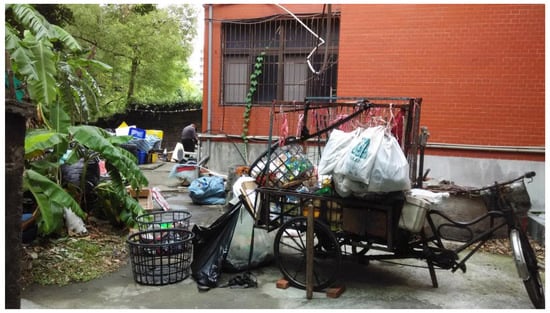
Figure 8.
Abo’s Production tools and activity space. Resource: photo by Yong Zhou.
Secondly, the everyday practices of an urban agriculture farm were created in the surroundings of the buildings, namely the floor 1 area and rooftop area (Figure 9). We built it to become a suitable planting space and for reclaimed land suitability. We created a mansion-building space, developed the rooftop gardens, and then expanded the scale of the space for breeding seedlings. This building is the teaching building of the author’s department. After communicating with the faculty of the institute, the urban farming experiment was approved. The author used the first floor, second floor, and top floor of the department as experimental spaces. On the first floor, the reclaimed idle land was used as a vegetable garden and old furniture was removed and reorganized to create a fence; the test space on the second floor was used to obtain space for growing flowers and plants by arranging the balcony; the functional area for growing vegetables on the roof was facilitated by the purchased soil potting equipment (Table 4). The reason for choosing the campus and the nearby area is that it is difficult to obtain unused land in the center of Taipei, so the campus and the community square (the second case) are the easiest to operate. In terms of the first case, the inclusive and pluralistic values of NTU’s Graduate Institute of Building and Planning provided a window of opportunity for us to experiment with urban agriculture in a public space of the university. We did not have to buy land from private hands, the school’s common space provided us with space to grow food.
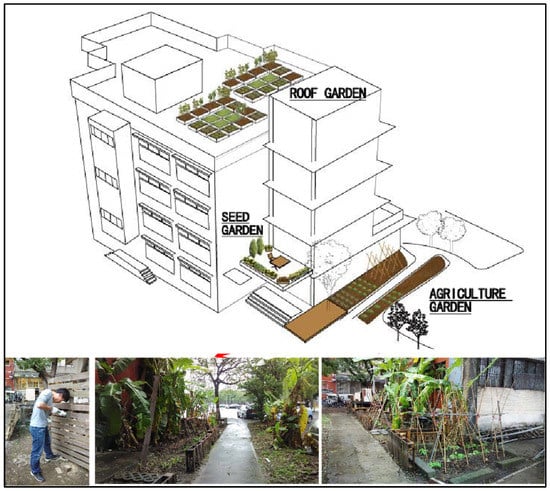
Figure 9.
Construction of urban agriculture farm (floor 1, floor 2, and roof).

Table 4.
Homework calendar in mansion garden.
4.3. Construction and Maintenance of Social Network in the Mansion Garden
As we created a good garden and planted the garden with Abo together, in the development process, we gradually established a learning network with Da’an Service Centre for the elderly. We found a mutual platform to allow Tzu Chi to become Abo’s social worker. In the subsequent farming process, in the production of organic crops, except for part of the space reserved for their use, others sell to Tzu Chi’s Taipei Branch, and forms the production network of “department + Da’an Service Centre for the elderly social skills training students +the old farming +Tzu Chi (buy/use)”. This section introduces the work on coupling social networks and space practice and the way to create a new network.
Firstly, we created a spatial structure of the three integrated space structures of “living garden + seedling garden + organic sales garden” in three spaces.
Garden base construction was divided into three parts: the mansion roof (120 square meters), the mansion on the second-floor balcony garden (about 60 square meters), the mansion building surrounding open space (about 50 square meters), and is, respectively, provided for the ecological and environmental protection of the vegetable and flower garden, nursery garden, and community public garden. (a) The ecological roof green vegetables flower garden: roof space was sufficient, the sunshine was complete, and the block model was divided in order to provide forty people space to grow edible vegetables and ornamental flowers. (b) On the second-floor balcony of the nursery garden—seedling cultivation and long term use could also combine with the educational community’s agricultural technology center. (c) The mansion on the first floor of the community garden—this part was implemented because a floor that could enter contact of the highest and also convenient for older people to participate in interactive.
We set up our brand “ABULEO” (Spanish, Abo’s meaning, Figure 10), and our urban agriculture production activities and social activities are rooted in the location.
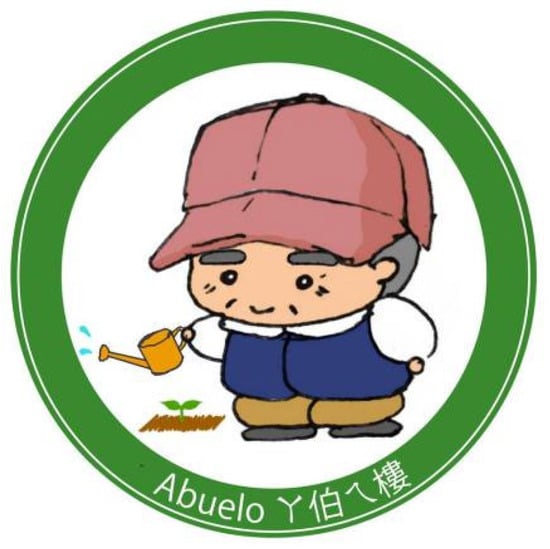
Figure 10.
Design for an urban farmer named Abuelo. Resource: designed by our team classmate Marina.
Secondly, we enhanced the social networks of supportive relationships. We constructed connections between the agricultural products sales network, sharing, and public education. In addition, we cooperated with welfare organizations, NGOs, and student groups to realize better the value of the work of the elderly (Figure 10).
As Figure 11 shows, there are eight types of actors. First, the organizers included a graduate institute and vegetable planting teams (i.e., Abo’s team). The graduate institute provided public space as a test base for urban farming and did not require the vegetable planting teams to bear the rent; the vegetable planting groups (Abo’s team) were responsible for taking care of the vegetable gardens twice/three times a week on a regular basis in terms of watering, fertilizing, weeding, and removing insects. They negotiated with Abo about the types of vegetables to be grown and matters related to the sale of vegetables. In terms of NGOs, the vegetable planting team was responsible for interfacing with Tzu Chi and the Daan Social Welfare Center. Tzu Chi visited Abo regularly every week and gave some material help (free meals, clothes). Every month, with the help of the vegetable planting team, they would buy the vegetables and greens grown by the planting team, and the sales proceeds would be given to the Abo. At the same time, professional volunteer teachers from the Daan Social Welfare Service Center would bring students from the Department of Social Work to care for Abo and organize the student lounge (i.e., the residence of Abo), where he lived. In addition, in terms of weakly associative actors, such as institute students and Abo’s family, although generating less interaction with Abo and the vegetable gardening team, one of the goals of this study was to observe whether the relationships between the less associative actors in the space would improve under the promotion of urban farming.
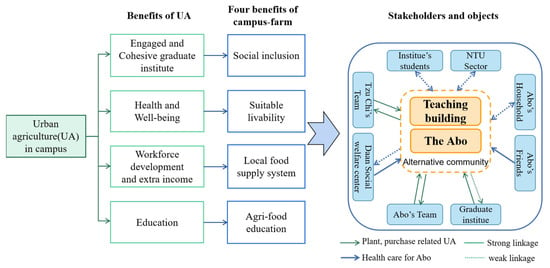
Figure 11.
Social support network of urban agriculture farm. Resource: designed by the author.
This study maps Figure 12 by sorting out the actor network. Vegetable planting teams were strongly associative actors who depended on the campus farm as an experimental spatial carrier. This strong relationality is shaped by students’ programs, which often lead to the termination of a program and the change of strong relationality to weak relationality due to students’ graduation. F1 and F2, participants in the program, said in an interview, “ Planting vegetables requires enthusiasm, but sustaining the project requires something institutionalized, something that is not affected by the cycle of graduation time, something that is constantly funded, and yet, this kind of experiment in planting vegetables may well be just fun for the students.” As Figure 11 shows, the actors in the campus-farm had the most stable connection, but they were also the most cyclical in time. This structural factor is also a vulnerability of the program. With the graduation of this student cohort, the program of caring for Abo was a castle in the air. Unfortunately, when the COVID-19 outbreak occurred in 2020, the school installed access control systems at all building entrances and used staff and student IDs as the only means of entering the department, which resulted in Abo, who had lived in the student lounge for 28 years, having to leave the school. This story of the school, the graduate institute, the students and the homeless elderly had come to an end.
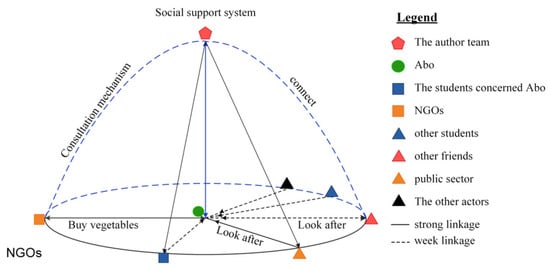
Figure 12.
Social support network of campus urban agriculture farm. Resource: designed by the author.
This campus-based urban farming experiment, which lasted for a year, was terminated due to a lack of people available to sustain the spatial program and outside resources (such as funding for farming aids and fertilizer). Nevertheless, returning to the participatory action research itself, this project made the authors of this study rethink what kind of social support network is needed for a sustainable urban farming experiment.
5. Case Research: Urban Agriculture Practices in Toad Mountain Settlement
There are successes and failures in urban agriculture experiments, and the failed experiences often become nutrients for new urban agriculture practices. Das and Ramaswami surveyed 6152 urban residents in three cities in the United States. They pointed out that community agricultural gardening (including indoor and outdoor) only has a 2% participation rate compared with family agriculture and gardening, which leads to low efficiency. On the other hand, family agriculture and gardening have a participation rate of 27% [63]. In Taipei, the participation rate of urban agriculture is high, especially in Toad Mountain Settlement.
Toad Mountain Settlement is located on the banks of Xindian Creek and next to the National Taiwan University. It is a mountain town built by urban and rural immigrants, and the only entirely preserved air force military-dependent village in Taipei City. It was designated as a “Taipei Cultural Landscape” in 2014. So far, there are still about 140 households in the area. In 2014, the author, as a volunteer, participated in the preservation project of the cultural landscape, and the construction of an urban community farm. Community Farm, established in 2015, has made its network of actors and social support system more robust and stable with the joint efforts of the community chief’s office, community associations, and school volunteer groups. Toad Mountain has also become a cultural base for ecological learning, urban agronomy, and military village culture in Taipei.
The specific development process of community gardens is as follows.
In 2014, the community NGO, the Good Toad Studio, applied for a grant of TWD 30,000 from a program of the Youth Development Administration, Ministry of Education. The studio found that many households had the habit of planting around their homes, so Ms. Lin, the student who initiated the program, wanted to promote interaction between residents by creating a common space for planting together. As a result, a community garden of 20 households with potted plants was created. At the same time, the village chief actively supported the vegetable garden activity, hoping to set up a public vegetable garden in the square near the fence, on the one hand, to facilitate residents to grow vegetables, on the other hand, to achieve the effect of greening the square to beautify the space. Ms. Lin invited student volunteers to purchase flowerpots, soil, and seeds and set up a raised wooden frame (hoping the seniors could stand and would not have to bend over) for vegetable gardening.
In 2015, Good Toad Studio started the second round of the community garden program, this time with a public garden named the vegetable shed.The first round of gardens (Figure 13) was privately adopted and planted, while the second round was jointly planted. Students were also invited to volunteer to lay bricks, cut wood, cut bamboo, erect posts, transport soil, and set up grids.
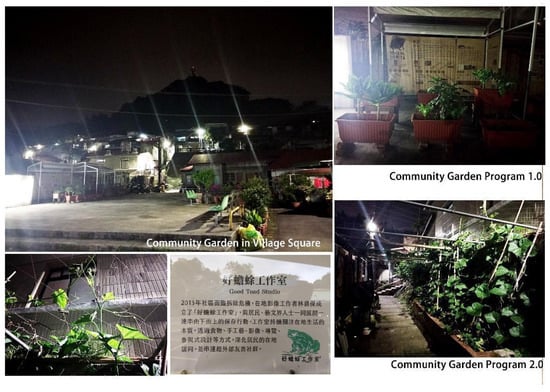
Figure 13.
Outcomes of community farm 1.0 Resource: photos by the author in 2017.
Since 2022, the community garden (Figure 14) has been in operation for more than 8 years. The village office has funded about TWD 30,000 annually since 2016, responsible for purchasing the expenses, planting, and tools needed for the community garden. It regularly invites urban agriculture specialists to provide lectures to impart planting experience. Thus, the community garden has gradually become an integral part of community life. It has also improved the residents’ sense of belonging in the community, beautified the landscape and environment, and promoted local livability. Although urban agriculture cannot fundamentally solve the survival and daily life of the non-native elderly, changes in group relations and social relations have begun in the community, including the development of personal relationships.

Figure 14.
Outcomes of community farm. Resource: photos by the authors.
6. Discussion and Conclusions
Urban agriculture is mainly an outdoor and indoor agricultural strategy used to grow food in a protected environment (such as buildings and greenhouses). This is a promising practice in agriculture. This paper found that urban agriculture provides opportunities for social interaction, community cohesion, self-sufficiency, and citizens’ health and welfare through the practice of urban agricultural gardens promoted by college students. Urban agriculture has advantages and disadvantages. In the future, this study combines case studies, qualitative interviews, and the current state of urban agriculture development in Taiwan to examine Taipei’s urban agriculture policy and consider the direction future developments.
6.1. Eat Sustainable and Healthy Food: Food Security in Urban
Existing research has yet to investigate how much food can be produced in urban areas on a global scale, nor have they determined what proportion of land is needed to support urban populations. From the perspective of food security, urban agriculture cannot ensure the self-sufficiency of vegetables for urban residents, and it is also more challenging to realize economic effects, not to mention solving the problem of food security [64]. Moreover, the costs associated with using urban agriculture to improve food security are high. The cost of building a supply chain that includes the storage, processing, distribution, and retailing of food to increase local food production is extremely high. It presents a colossal challenge to urban agricultural practitioners [65], and raises a question about whether urban agriculture is increasingly incorporated into food system policies.
In terms of the two cases above, food production is mainly for the community. As the interviewee stated, “Farming on campus can add at least 200TWD per week to your income, and to some extent, the grower can be self-sufficient for a small family’s use of fruits and vegetables (F3)”.
“In Toad Mountain community farm, we mainly hope that through the community farm, we can solve the daily urgent need of some food, such as green onion, green pepper, small green vegetables, daily cooking to the square’s vegetable garden to pick a little, it is very convenient, so we do not have to go to the supermarket specifically to buy vegetables (F4, F5)”. At the same time, urban agriculture has become an interface or medium for residents to interact with each other.
In the case of Taipei City’s urban agricultural development, small-scale farm food production is generally for urban farmers’ own use, and medium-scale urban farms provide excess produce to food banks for bartering. However, the agricultural products from urban farming are different from the agricultural products in the established industrialized and globalized food system. Urban farming serves the greater purpose of simply providing an opportunity for city dwellers to increase their awareness of green products and their knowledge of green food. Thus, urban agriculture in Taipei is less economically efficient in food production, and urban farmers are more concerned with the sociocultural effects of farming.
G2 said, “Taipei’s urban agriculture policy has yet to be implemented as expected. On the one hand, the leisure group’s farm gardens often fail, such as the rooftop vegetable garden program. Urban farmers, in their enthusiasm waning, usually set aside, put aside, ignore, do not care, ignore the crops planted! On the other hand, in the case of urban farmers as a profession, they mostly complain that the area of the planted farm garden is so small that it is not economically profitable, which leads the farmers to leave and rent their land (larger size) for farming”.
Urban farmers can generally meet the demand for food production, regardless of whether they have small-, medium-, or large-scale farms. Specifically, to sustain their businesses, professionals must arrange to take care of small-scale farms and form standardized management. For medium-scale urban farms, their planting area should be appropriately increased to meet the urban farmers’ reasonable demand for economic benefits of scale.
6.2. Bringing the Food and Agriculture Education Back into the Urban
The Food Education Act (2005) was enacted in Japan in 2005, making “Shokuiku” (food education) the foundation of intellectual, physical, and moral education so that children can develop healthy eating habits, knowledge of diet, and good food judgment [66]. The United States Department of Agriculture (USDA) has been promoting the “farm to school” program since 2012, allowing public schools to procure ingredients from local farms to teach students about food production. Some schools have even set up vegetable gardens directly on their campuses [67]. In Taiwan, since the 1980s, tourist and civic farms have led to widespread attention to the issue of “food and farming education.” Urban agriculture policies have been introduced to primary, secondary, and university campuses since 2013. Among them, that of the National Taiwan University (NTU) is the most prominent, with the rooftop garden of the Department of Psychology, the rooftop garden of the Department of Sociology (Figure 15), and the Shaoxing Community Farm (located on the NTU campus).
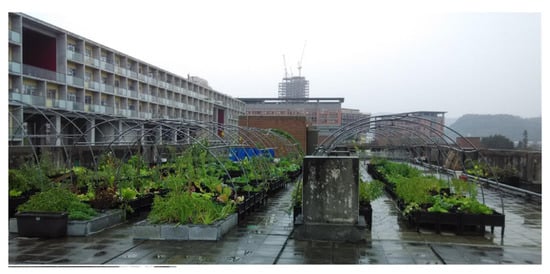
Figure 15.
Rooftop farm, Department of Sociology, National Taiwan University. Note: NTU’s rooftop farm was born out of a practical product of NTU’s academic course. The student team wanted to conceptualize community housing as a community living concept, and the ideal community plan included a rooftop farm, a community kitchen, and an elderly care garden. With the help of the school, the rooftop farm grew from scratch, from space design, fruit and vegetable gardening, organic fertilizer production, and crop exchange, to food learning. It has become one of the representatives of the campus farm. Resource: photos by the author.
On 4 May 2022, the President’s Office officially announced the implementation of the “Food and Agriculture Education Act”. The essence of food and agriculture education is to promote food and agriculture education to reconnect with the land, rebuild relationships with agricultural producers, and regain the joy of cooking and eating together with family and friends. For the community, food and agriculture education are beneficial to the development of rural industries and the maintenance of local food culture; for individuals, food and agriculture education is helpful in the establishment of good eating habits and reduction of food waste. For the environment, food and agriculture education helps establish an environmentally-friendly agricultural production and marketing model that promotes environmental sustainability. A long-time campus farm teacher said, “When students participate in farming activities, we often observe students’ curiosity. Participating in such activities prompts them to keep the changes of garden organisms to plants, which is the best field for students to learn on their own, in the school farm, not to learn to become farmers but to develop their attitude towards food and land (P2)”.
“Urban agriculture allows children to experience the beauty of the natural environment amid the urban concrete jungle and mitigates the impact of children’s nature deficit disorder” (P3).
Lin (2022) proposed the “ABC model of food and agriculture education” (Figure 16), which advocates a conceptual framework of three aspects and six items of food and agriculture education and the goal of cultivating “food and agriculture literacy” through an experiential learning strategy of “learning by doing.” This model is an essential reference for the Taiwan Council of Agriculture to encourage schools, communities, community organizations, and agricultural enterprises to propose food and agriculture education promotion programs [68].
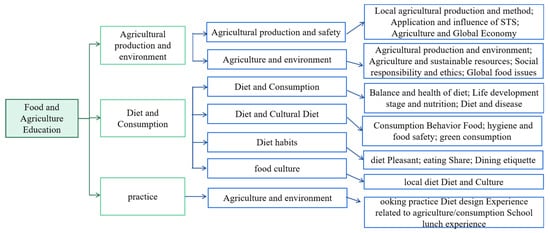
Figure 16.
The framework of food and agriculture education. Resource: according to Lin (2022).
Expressly, the concept of “Food and Agriculture Education”, “Food literacy”, and “agricultural literacy” is understood in terms of their conceptual development and their interconnectedness. School lunch is a critical practice that helps maintain and improve children’s health by providing a nutritious and balanced diet. School lunches are afforded significant educational meaning by promoting local ingredients in school lunches, using lunch ingredients to integrate food and nutrition education, conducting thematic activities during lunchtime, and further linking them to subject-related learning.
6.3. Growing a Stronger Active Community and Building a Resilient Society
Under the dichotomy between urban and rural areas in Taiwanese society, creating urban farms is a fundamental and innovative issue. The actors (including civic groups, schools, government agencies, community offices, village chiefs, and NGOs) have worked together to build a friendly and vibrant resilient society in Taipei and promote Taipei to become a garden city.
In particular, the civil society groups represented by FUN are the key to promoting a more inclusive, friendly, energetic, and creative Taipei. P1 says, “Urban agriculture is not only about growing vegetables, but also about playing with all kinds of creativity, and Treasure Hill (Figure 4) is a product of creativity, art, and life”. The village chiefs who serve the community’s residents mobilize, lobby, and negotiate, thereby creating urban farming gardens that draw residents closer to each other in the community’s public space. There are also Taipei citizens who love public participation in the process of urban agriculture. “Some urban farmers are very active because they are older and love to love growing vegetables, but they are limited to planting and sending the vegetables around at each harvest” (F6). In other words, urban farmers grow visible and edible fruits and vegetables on the farms of urban society, enjoying the interaction with the ecological environment and shaping the diversity of urban space.
This paper tells us that the operation and management of the mansion garden and the Toad Mountain community farm can help people understand food and farming, enhance the understanding of the location of sense, beautify the landscape and environment, and strengthen the interaction among people. Urban agriculture presents a viable method to address the need for self-cooking in everyday life among urban citizens and balancing production from urban and peri-urban areas. Although, it has many advantages; however, urban agriculture should be perceived as something other than a panacea for food insecurity.
There are about 740 public farms in Taiwan, including community farms, collective residential farms, corporate employee farms, fruit tree parks, and civic farms. In addition, the number of schools with campus farming is estimated to be about 400. These urban agricultural spaces bring positive benefits to the lives of participants. The vast majority of public farms are in Taipei City. After eight years of urban agricultural policy construction from 2014 to 2022, urban agriculture has become a right for Taipei residents.
However, on 26 November 2022, Chiang Wan-an was elected as the mayor of Taipei City. His political views did not involve urban agriculture policies, and the future development of urban agriculture policies remains to be seen. Will the land be taken back into government ownership (e.g., Happy Farm, Shaoxing Community Farm)? Each village can apply for a TWD 30,000 urban agriculture subsidy each year. Will a stable funding injection will have any bearing on whether or not neighborhood participants can continue to participate also remains to be seen. These factors will affect the future progress of urban farming in Taipei.
Author Contributions
Conceptualization, Y.Z. (Yong Zhou); methodology, Y.Z. (Yong Zhou); validation, Y.Z. (Yan Zhou), C.W. and Y.Z. (Yong Zhou); formal analysis, Y.Z. (Yan Zhou), C.W. and Y.Z. (Yong Zhou); investigation, C.W. and Y.Z. (Yong Zhou); resources, Y.Z. (Yan Zhou) and C.W.; data curation, C.W. and Y.Z. (Yong Zhou); writing—original draft preparation, Y.Z. (Yan Zhou) and Y.Z. (Yong Zhou); writing—review and editing, Y.Z. (Yan Zhou) and Y.Z. (Yong Zhou); visualization, Y.Z. (Yong Zhou); supervision, Y.Z. (Yan Zhou) and Y.Z. (Yong Zhou); project administration, Y.Z. (Yong Zhou); funding acquisition, Y.Z. (Yan Zhou) and C.W. All authors have read and agreed to the published version of the manuscript.
Funding
This article was subsidized for English editing by National Taiwan University under the Excellence Improvement Program for Doctoral Students (grant number 108-2926-I-002-002-MY4), sponsored by Ministry of Science and Technology, Taiwan.
Data Availability Statement
Not applicable.
Acknowledgments
We are grateful to thank you for the comments in “An Attempt of Spatial Building and Planning based on the Healthy Aging and Urban Agriculture: a case of National Taiwan University”, 13th International Congress of Asian Planning Schools Association, Johor Bahru, Malaysia. In addition, we also thank you for the effects of team classmates.
Conflicts of Interest
The authors declare no conflict of interest.
References
- Hinrichs, C.C. The practice and politics of food system localization. J. Rural. Stud. 2003, 19, 33–45. [Google Scholar] [CrossRef]
- Godfray, H.C.J.; Beddington, J.R.; Crute, I.R.; Haddad, L.; Lawrence, D.; Muir, J.F.; Pretty, J.; Robinson, S.; Thomas, S.M.; Toulmin, C. Food security: The challenge of feeding 9 billion people. Science 2010, 327, 812–818. [Google Scholar] [CrossRef]
- Hickel, J. The true extent of global poverty and hunger: Questioning the good news narrative of the Millennium Development Goals. Third World Q. 2016, 37, 749–767. [Google Scholar] [CrossRef]
- UNICEF. The State of Food Security and Nutrition in the World 2021. Available online: https://www.wfp.org/publications/2021-state-food-security-and-nutrition-world-report-and-inbrief (accessed on 14 October 2022).
- Mok, H.F.; Williamson, V.G.; Grove, J.R.; Burry, K.; Barker, S.F.; Hamilton, A.J. Strawberry fields forever? Urban agriculture in developed countries: A review. Agron. Sustain. Dev. 2014, 34, 21–43. [Google Scholar] [CrossRef]
- Van Tuijl, E.; Hospers, G.J.; Van Den Berg, L. Opportunities and challenges of urban agriculture for sustainable city development. Eur. Spat. Res. Policy 2018, 25, 5–22. [Google Scholar] [CrossRef]
- Çelik, F. The importance of edible landscape in the cities. Turk. J. Agric.-Food Sci. Technol. 2017, 5, 118–124. [Google Scholar] [CrossRef]
- Menyuka, N.N.; Sibanda, M.; Bob, U. Perceptions of the challenges and opportunities of utilising organic waste through urban agriculture in the Durban South Basin. Int. J. Environ. Res. Public Health 2020, 17, 1158. [Google Scholar] [CrossRef]
- Wadumestrige Dona, C.G.; Mohan, G.; Fukushi, K. Promoting urban agriculture and its opportunities and challenges—a global review. Sustainability 2021, 13, 9609. [Google Scholar] [CrossRef]
- Gilleard, C.; Higgs, P. The third age and the baby boomers. Int. J. Ageing Later Life 2007, 2, 13–30. [Google Scholar] [CrossRef]
- United Nations Population Division. World Population Prospects: The 2019 Revision. Population, Surface Area, and Density. 2020. Available online: https://population.un.org/wpp/publications/files/wpp2019_databooklet.pdf (accessed on 14 October 2022).
- Michel, J.P.; Sadana, R. Healthy aging concepts and measures. J. Am. Med. Dir. Assoc. 2017, 18, 460–464. [Google Scholar] [CrossRef]
- Philips, A. Designing Urban Agriculture: A Complete Guide to the Planning, Design, Construction, Maintenance and Management of Edible Landscapes; John Wiley & Sons: Hoboken, NJ, USA, 2013. [Google Scholar]
- Tayobong, R.R.P.; Sanchez, F.C.; Balladares, M.C.E.; Medina, N.G. Edible landscaping in the Philippines: Maximizing the use of small spaces for aesthetics and crop production. J. Dev. Sustain. Agric. 2013, 8, 91–99. [Google Scholar]
- Hoang, V. Modern short food supply chain, good agricultural practices, and sustainability: A conceptual framework and case study in Vietnam. Agronomy 2021, 11, 2408. [Google Scholar] [CrossRef]
- Steenkamp, J.; Cilliers, E.J.; Cilliers, S.S.; Lategan, L. Food for Thought: Addressing Urban Food Security Risks through Urban Agriculture. Sustainability 2021, 13, 1267. [Google Scholar] [CrossRef]
- Eigenbrod, C.; Gruda, N. Urban vegetable for food security in cities. A review. Agron. Sustain. Dev. 2015, 35, 483–498. [Google Scholar] [CrossRef]
- Dobele, M.; Zvirbule, A. The concept of urban agriculture–Historical development and tendencies. Rural Sustain. Res. 2020, 43, 20–26. [Google Scholar] [CrossRef]
- Montgomery, M.R. The urban transformation of the developing world. Science 2008, 319, 761–764. [Google Scholar] [CrossRef]
- Vejre, H.; Eiter, S.; Hernandez-Jimenez, V.; Loupa-Ramos, I.; Recasens, X.; Pickard, D.; Scazzosi, L.; Simon-Rojo, M. Can agriculture be Urban? In Urban Agriculture Europe; Lohrberg, F., Licka, L., Scazzosi, L., Timpe, A., Eds.; Jovis: Berlin, Germany, 2016; pp. 18–22. [Google Scholar]
- Howard, E. Garden Cities of Tomorrow, 2nd ed.; S Sonnenschein: London, UK, 1902; pp. 2–7. [Google Scholar]
- Miller, M. English Garden Cities: An Introduction; Historic England: London, UK, 2015. [Google Scholar]
- Warsh, M. Cultivating citizens: The children’s school farm in new york city, 1902–1931. Build. Landsc. J. Vernac. Archit. Forum 2011, 18, 64–89. [Google Scholar] [CrossRef]
- Parham, S. Food and Welwyn Garden City: Prescribing a sociable future? Town Ctry. Plan. Assoc. J. 2020, 8, 242–245. [Google Scholar]
- Smit, J.; Nasr, J.; Ratta, A. Urban agriculture: Food, jobs and sustainable cities. N. Y. USA 1996, 2, 35–37. [Google Scholar]
- Thompson, J.H. Urban Agriculture in Southern Japan. Econ. Geogr. 1957, 33, 224–237. [Google Scholar] [CrossRef]
- Nugent, R. The impact of urban agriculture on the household and local economies. In Growing Cities, Growing Food. Urban Agriculture on the Policy Agenda; Bakk, N., Dubbeling, M., Gündel, S., Sabel-Koshella, U., De Zeeuw, H., Eds.; Zentralstelle für Ernährung und Landwirtschaft (ZEL): Feldafing, Germany, 2000; Volume 42, pp. 67–95. [Google Scholar]
- Besthorn, F.H. Vertical farming: Social work and sustainable urban agriculture in an age of global food crises. Aust. Soc. Work 2013, 66, 187–203. [Google Scholar] [CrossRef]
- Puri, V.; Caplow, T. How to Grow Food in the 100% Renewable City: Building-Integrated Agriculture. In 100 Per Cent Renewable; Routledge: London, UK, 2009; pp. 255–268. [Google Scholar]
- Thomaier, S.; Specht, K.; Henckel, D.; Dierich, A.; Siebert, R.; Freisinger, U.B.; Sawicka, M. Farming in and on urban buildings: Present practice and specific novelties of Zero-Acreage Farming (ZFarming). Renew. Agric. Food Syst. 2015, 30, 43–54. [Google Scholar] [CrossRef]
- WinklerPrins, A.M. Global Urban Agriculture: Convergence of Theory and Practice between North and South; CABI: Boston, MA, USA, 2017. [Google Scholar]
- Menconi, M.E.; Heland, L.; Grohmann, D. Learning from the gardeners of the oldest community garden in Seattle: Resilience explained through ecosystem services analysis. Urban For. Urban Green. 2020, 56, 126878. [Google Scholar] [CrossRef]
- Takahashi, N.; Kanno, M. A review of studies on metropolitan areas in Japan. Geogr. Rev. Jpn. 1988, 61, 111–119. [Google Scholar] [CrossRef][Green Version]
- Noriko, N. How Urban Agriculture Can Contribute to Green Infrastructure in Japanese Cities. In Urban Services to Ecosystem: Green Infrasture Benefits from the Landscape to the Urban Scale; Springer: Cham, Switzerland, 2021; pp. 227–242. [Google Scholar]
- Górna, A.; Górny, K. Singapore vs. the ‘Singapore of Africa’—Different Approaches to Managing Urban Agriculture. Land 2021, 10, 987. [Google Scholar] [CrossRef]
- LaCroix, C.J. Urban agriculture and other green uses: Remaking the shrinking city. Urban Lawyer 2010, 42, 225–285. [Google Scholar]
- Cabannes, Y. Financing urban agriculture. Environ. Urban. 2012, 24, 665–683. [Google Scholar] [CrossRef]
- Krikser, T.; Piorr, A.; Berges, R.; Opitz, I. Urban agriculture oriented towards self-supply, social and commercial purpose: A typology. Land 2016, 5, 28. [Google Scholar] [CrossRef]
- Ilieva, R.T.; Cohen, N.; Israel, M.; Specht, K.; Fox-Kämper, R.; Fargue-Lelièvre, A.; Poniży, L.; Schoen, V.; Caputo, S.; Kirby, C.K.; et al. The Socio-Cultural Benefits of Urban Agriculture: A Review of the Literature. Land 2022, 11, 622. [Google Scholar] [CrossRef]
- Lefebvre, H. Space: Social Product and Use Value. In State, Space, World: Selected Essays; University of Minnesota Press: Minneapolis, MN, USA, 2009. [Google Scholar]
- Iecovich, E. Aging in Place: From Theory to Practice. Anthropological Notebooks 2014, 20, 21–33. [Google Scholar]
- Lilja, M.; Bergh, A.; Johansson, L.; Nygard, L. Attitudes towards rehabilitation needs and support from assistive technology and the social environment among elderly people with disability. Occup. Ther. Int. 2003, 10, 75. [Google Scholar] [CrossRef] [PubMed]
- Yang, P.S. Revitalizing roles of older adult citizens: Successful stories of project history alive. Ageing Int. 2013, 38, 137–148. [Google Scholar] [CrossRef]
- Callander, E.J.; Deborah, J.S.; Rupendra, N.S. Multiple disadvantages among older citizens: What a multidimensional measure of poverty can show. J. Aging Soc. Policy 2012, 24, 368–383. [Google Scholar] [CrossRef] [PubMed]
- Heidegger, M. Building Dwelling Thinking. In Visual Culture: Critical Concepts in Media and Cultural Studies; Routledge: London, UK, 1951; pp. 66–76. [Google Scholar]
- Holst, J. Rethinking dwelling and building. Zarch 2014, 2, 52–61. [Google Scholar]
- Yager, J.A. Transforming agriculture in Taiwan. In Transforming Agriculture in Taiwan; Cornell University Press: New York, NY, USA, 2019. [Google Scholar]
- Boestel, J.; Francks, P.; Kim, C.H. Agriculture and Economic Development in East Asia: From Growth to Protectionism in Japan, Korea and Taiwan; Routledge: London, UK, 2013. [Google Scholar]
- Tao, Y.H.; Wang, R.Y.; Ling, H.C.; Chu, J.Y.; Ji, H. Implementing for Innovative Management of Green Tourism and Leisure Agriculture in Taiwan. Int. J. Organ. Innov. 2021, 13, 210–219. [Google Scholar]
- Lee, M.H. Tourism and sustainable livelihoods: The case of Taiwan. Third World Q. 2008, 29, 961–978. [Google Scholar] [CrossRef]
- Hou, J. Governing urban gardens for resilient cities: Examining the ‘Garden City Initiative’in Taipei. Urban Stud. 2020, 57, 1398–1416. [Google Scholar] [CrossRef]
- Farming Urbanism Network. Shovel Revolution: From Farming Urbanism Network to Garden City Taipei; Hou, J., Ed.; City Commoning; Rive Gauche Publishing House: New Taipei, Taiwan, 2019; pp. 208–222. [Google Scholar]
- Xu, R.H.; Zheng, X.G. Urban agriculture: New scenic line in Taiwan. Econ. Forw.-Look. 2020, 192, 55–60. [Google Scholar]
- You, W.T.; Su, Y.M. Urban Agriculture Trends and Future Strategy in Taipei City. J. Prop. Manag. 2021, 12, 55–60. [Google Scholar]
- Jorgensen, D.L. Participant Observation: A Methodology for Human Studies; Sage: Thousand Oaks, CA, USA, 1989; pp. 12–26. [Google Scholar]
- Lewin, K. Action research and minority problems. J. Soc. Issues 1946, 2, 34–46. [Google Scholar] [CrossRef]
- Chein, I.; Stuart, W.C.; Harding, J. The field of action research. Am. Psychol. 1948, 3, 43. [Google Scholar] [CrossRef]
- Suzanne, D. A reflexive lens: Exploring dilemmas of qualitative methodology through the concept of reflexivity. Qual. Sociol. Rev. 2012, 8, 60–85. [Google Scholar]
- Bogdewic, S.P. Participant observation. In Doing qualitative research 1992; Crabtree, B.F., Miller, W.L., Eds.; Sage: New York, NY, USA, 1992; pp. 45–69. [Google Scholar]
- Zhou, Y. Locality from Hybridization to Integration: Cultural Politics and Space Production of Taiwan Mazu Temples in Mainland China. Religions 2022, 13, 836. [Google Scholar] [CrossRef]
- Al-Kodmany, K. The vertical farm: A review of developments and implications for the vertical city. Buildings 2018, 8, 24. [Google Scholar] [CrossRef]
- Wu, L.F. Greening by Self-organised Urban Farming: A Productive Paradigm for Urban Green Space in China. In Green Infrastructure in Chinese Cities; Springer: Singapore, 2022; pp. 143–172. [Google Scholar]
- Das, K.; Ramaswami, A. Who Gardens and How in Urban USA: Informing Social Equity in Urban Agriculture Action Plans. Front. Sustain. Food Syst. 2022, 6, 923079. [Google Scholar] [CrossRef]
- Martellozzo, F.; Landry, J.-S.; Plouffe, D.; Seufert, V.; Rowhani, P.; Ramankutty, N. Urban agriculture: A global analysis of the space constraint to meet urban vegetable demand. Environ. Res. Lett. 2014, 9, 064025. [Google Scholar] [CrossRef]
- Ackerman, K. Urban agriculture: Opportunities and constraints. In Metropolitan Sustainability; Woodhead Publishing: Sawston, UK, 2012; pp. 118–146. [Google Scholar]
- Miyoshi, M.; Nobuyo, T.K.; Nobuo, N. School-based “Shokuiku” program in Japan: Application to nutrition education in Asian countries. Asia Pac. J. Clin. Nutr. 2012, 21, 159–162. [Google Scholar]
- Botkins, E.R.; Brian, E.R. Understanding participation in farm to school programs: Results integrating school and supply-side factors. Food Policy 2018, 74, 126–137. [Google Scholar] [CrossRef]
- Lin, J.P. Conceptual Framework and Promotion Strategies of Food and Agriculture Education. Prospect. Agric. Sci. Technol. Cent. Taiwan 2022, 145, 82–94. [Google Scholar]
Disclaimer/Publisher’s Note: The statements, opinions and data contained in all publications are solely those of the individual author(s) and contributor(s) and not of MDPI and/or the editor(s). MDPI and/or the editor(s) disclaim responsibility for any injury to people or property resulting from any ideas, methods, instructions or products referred to in the content. |
© 2022 by the authors. Licensee MDPI, Basel, Switzerland. This article is an open access article distributed under the terms and conditions of the Creative Commons Attribution (CC BY) license (https://creativecommons.org/licenses/by/4.0/).